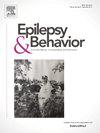Semiological feature of epileptic seizures originated from subgenual ventromedial prefrontal cortex: Insight from neuroethological view
IF 2.3
3区 医学
Q2 BEHAVIORAL SCIENCES
引用次数: 0
Abstract
Objective
Seizures originating from the ventromedial prefrontal cortex (vmPFC) have been infrequently documented in prior literature. The purpose of the present study is to highlight the semiological features of seizures arising from subgenual vmPFC.
Method
We presented three cases with stereoelectroencephalography (SEEG)-confirmed epileptogenic zones localized to the subgenual vmPFC (sg-vmPFC), all achieving favorable surgical outcomes (seizure freedom or significant reduction).
Results
Distinct from the panic-driven behaviors (e.g., agitation, hyperkinetic movements) reported in seizures involving the pregenual anterior cingulate or orbitofrontal cortex, the semiology of our cases was characterized by anxiety-related and risk-assessment behaviors, such as visual scanning, olfactory exploration (sniffing), oral automatisms (lip-licking), and manual exploration (hand fumbling), accompanied by vigilant/anxious facial expressions. These features closely align with the pre-threat phase of the Threat Imminence Continuum Theory, which prioritizes environmental surveillance and threat anticipation over immediate defensive actions.
Conclusion
Based on our findings, we propose that anxiety-dominated behaviors should be recognized as semiological hallmarks of seizures triggered by vmPFC hyperactivation or early ictal involvement. This paradigm challenges traditional classifications that conflate anxiety and panic semiology, offering a refined framework for localizing vmPFC-related epilepsy and tailoring interventions to its unique network dynamics.
源自亚属腹内侧前额叶皮层的癫痫发作的符号学特征:从神经行为学角度的洞察
目的:在以前的文献中,很少有文献记载起源于腹内侧前额叶皮层(vmPFC)的癫痫发作。本研究的目的是强调亚属vmPFC引起的癫痫发作的符号学特征。方法我们报告了3例立体脑电图(SEEG)证实的癫痫发生区位于亚属vmPFC (sg-vmPFC)的病例,所有病例均获得了良好的手术结果(癫痫发作自由或显著减轻)。结果:不同于恐慌驱动的行为(如躁动、多动运动),我们病例的符号学特征是焦虑相关和风险评估行为,如视觉扫描、嗅觉探索(嗅闻)、口腔自动性(舔唇)和手动探索(手摸索),伴有警惕/焦虑的面部表情。这些特征与威胁迫近连续体理论的威胁前阶段密切相关,该理论优先考虑环境监测和威胁预测,而不是立即采取防御行动。结论:基于我们的研究结果,我们认为焦虑主导的行为应该被认为是由vmPFC过度激活或早期危象参与引发的癫痫发作的符号学标志。这一范式挑战了将焦虑和恐慌符会学混为一谈的传统分类,为定位vmpfc相关癫痫和根据其独特的网络动态量身定制干预措施提供了一个完善的框架。
本文章由计算机程序翻译,如有差异,请以英文原文为准。
求助全文
约1分钟内获得全文
求助全文
来源期刊

Epilepsy & Behavior
医学-行为科学
CiteScore
5.40
自引率
15.40%
发文量
385
审稿时长
43 days
期刊介绍:
Epilepsy & Behavior is the fastest-growing international journal uniquely devoted to the rapid dissemination of the most current information available on the behavioral aspects of seizures and epilepsy.
Epilepsy & Behavior presents original peer-reviewed articles based on laboratory and clinical research. Topics are drawn from a variety of fields, including clinical neurology, neurosurgery, neuropsychiatry, neuropsychology, neurophysiology, neuropharmacology, and neuroimaging.
From September 2012 Epilepsy & Behavior stopped accepting Case Reports for publication in the journal. From this date authors who submit to Epilepsy & Behavior will be offered a transfer or asked to resubmit their Case Reports to its new sister journal, Epilepsy & Behavior Case Reports.
 求助内容:
求助内容: 应助结果提醒方式:
应助结果提醒方式:


